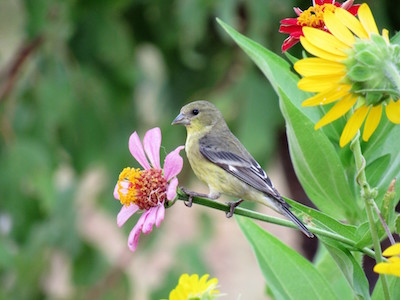Question: I’m adding plants to my home landscape, and I’d like to make it a bird-friendly habitat. What are some bird-friendly plants?
- Yours Truly (Marisa Thompson), Los Lunas
 Lesser goldfinch on a zinnia stem next to sunflowers in Las Cruces (July 2016). Photo credit Brian Houghton.Answer: This week’s question is one of my own! I have had good luck with hummingbird feeders, but I’m ready to take it up a notch. I bought a snazzy feeder a few months ago to hang near my back patio. I filled it with a seed mix, but haven’t seen a single bird yet; maybe it’s the wrong food or wrong location in the yard? I’m hoping that the newly planted trees, shrubs, and perennial flowers, including desert willow, Arizona rosewood, three-leafed sumac, penstemons, and hummingbird trumpet plants, will attract more birds to my garden and neighborhood.
Lesser goldfinch on a zinnia stem next to sunflowers in Las Cruces (July 2016). Photo credit Brian Houghton.Answer: This week’s question is one of my own! I have had good luck with hummingbird feeders, but I’m ready to take it up a notch. I bought a snazzy feeder a few months ago to hang near my back patio. I filled it with a seed mix, but haven’t seen a single bird yet; maybe it’s the wrong food or wrong location in the yard? I’m hoping that the newly planted trees, shrubs, and perennial flowers, including desert willow, Arizona rosewood, three-leafed sumac, penstemons, and hummingbird trumpet plants, will attract more birds to my garden and neighborhood.
I heard through the Valencia County Extension Master Gardener grapevine that Dan Garrison would be a good local person to ask for recommendations on inviting more birds. I was immediately encouraged because Garrison said he and his wife started with native and adapted trees and shrubs to build a bird-attractive yard and that they also have a pollinator-friendly flower meadow. The Xerces Society Guide “Attracting Native Pollinators” points out that in addition to creating habitat for beneficial insects by landscaping with pollinator-friendly plants, you’re also enhancing the habitat for other animals like birds and lizards: “More than 90 percent of birds rely on insects during at least one stage of their life.”
I saw a woodpecker in my mulberry tree last winter, and for Christmas my aunt gave me a special woodpecker hanging feeder with shallow holes that you’re supposed to fill with a special spicy paste (I know it’s spicy because I accidentally tasted a tiny bit), but I haven’t seen any birds take an interest in it. Garrison said, “Sometimes the birds don’t readily identify the pastes as food. If you press seed into the paste, they will usually find out they like the paste too.” He added, “The woodpeckers, flickers, nuthatches, and bushtits like seed cylinders. The sparrows, finches, grosbeaks, etc. like the larger seeds like black sunflower and safflower seeds with a mix of smaller seed, such as millet. The dove, though larger, prefer the smaller seeds.”
In Los Lunas, we are just an hour north of the Bosque del Apache National Wildlife Refuge. According to their website (https://www.fws.gov/refuge/Bosque_del_Apache), over 500 birds from 81 different species were sighted and reported during just one day last week. The following tips are listed for an enhanced “wildlife watching experience” while visiting the refuge, and I intend to try some of them out at my house as well:
- Dawn and dusk are the best times to see wildlife.
- Observe from the sidelines. Leave “abandoned” young animals alone. A parent is probably close by waiting for you to leave.
- Don’t offer snacks; your lunch could disrupt wild digestive systems.
- For a closer look, bring binoculars.
- Try sitting quietly in one good location. Let wildlife get used to your presence. Many animals that have hidden will reappear once they think you are gone.
- Walk quietly and be aware of sounds and smells. Often you will hear more than you will see.
- Teach children quiet observation. Other wildlife watchers will appreciate your consideration.
- Look for animal signs. Tracks, scat, feathers, and nests left behind often tell interesting stories.
One more tip on their website encourages growing late-season sunflowers for fall bird forage. Depending on how early your first frost date will be this year, you might barely have time to plant sunflower seeds and get flowers this season if you plant them right now. Check seed packet information for the number of days to maturity; the shortest seems to be around 70 days. Our average first frost in Valencia County is mid to late October, so there’s still hope.
Are you a backyard birder? What works best in your garden? Share your birding tips with me via email (desertblooms@nmsu.edu) or social media (@NMDesertBlooms) and I’ll post them on the blog version of this week’s column (https://nmsudesertblooms.blogspot.com/). I’ll also list helpful books and resources, like New Mexico author Marcy Scott’s beautiful book “Hummingbird Plants of the Southwest,” links to user-friendly bird identification apps “iNaturalist” and “eBird,” and photos of the new plants in my garden.
For more gardening information, including decades of archived Southwest Yard & Garden columns, visit the NMSU Extension Horticulture page (http://desertblooms.nmsu.edu/), follow us on social media (@NMDesertBlooms), or contact your County Extension office (https://aces.nmsu.edu/county).
Marisa Thompson, PhD, is the Extension Horticulture Specialist for New Mexico State University and is based at the Agricultural Science Center at Los Lunas.


